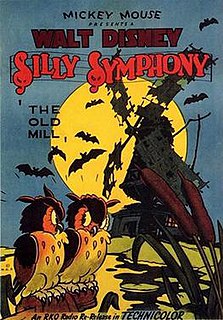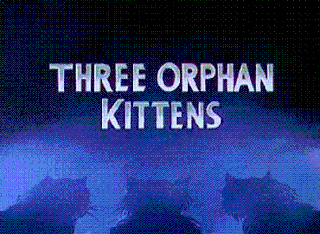
Pluto, also called Pluto the Pup, is a cartoon dog created in 1930 at Walt Disney Productions. He is a yellow-orange color, medium-sized, short-haired dog with black ears. Unlike most Disney characters, Pluto is not anthropomorphic beyond some characteristics such as facial expression. He is Mickey Mouse's pet. Officially a mixed-breed dog, he made his debut as a bloodhound in the Mickey Mouse cartoon The Chain Gang. Together with Mickey Mouse, Minnie Mouse, Donald Duck, Daisy Duck, and Goofy, Pluto is one of the "Sensational Six"—the biggest stars in the Disney universe. Though all six are non-human animals, Pluto alone is not dressed as a human.

Theodore H. "Ted" Osborne was an American writer of comics, radio shows and animated films, remembered for his contributions to the creation and refinement, during the 1930s, of Walt Disney cartoon characters.

The Wise Little Hen is a Walt Disney's Silly Symphony cartoon, based on the fairy tale The Little Red Hen. The cartoon marked the debut of Donald Duck, dancing to the Sailor's Hornpipe. Donald and his friend Peter Pig try to avoid work by faking stomach aches until Mrs. Hen teaches them the value of labor. This cartoon was released on June 9, 1934. It was animated by Art Babbitt, Dick Huemer, Clyde Geronimi, Louie Schmitt, and Frenchy de Tremaudan and directed by Wilfred Jackson. The story was also adapted in the Silly Symphony Sunday comic strip by Ted Osborne and Al Taliaferro, which was Donald Duck's first appearance in Disney comics.

Silly Symphony is a series of 75 animated short films produced by Walt Disney Productions from 1929 to 1939. As their name implies, the Silly Symphonies were originally intended as whimsical accompaniments to pieces of music. As such, the films usually had independent continuity and did not feature continuing characters, unlike the Mickey Mouse shorts produced by Disney at the same time. The series is notable for its innovation with Technicolor and the multiplane motion picture camera, as well as its introduction of the character Donald Duck making his first appearance in the Silly Symphony cartoon The Wise Little Hen in 1934. Seven shorts won the Academy Award for Best Animated Short Film.

Bambi, a Life in the Woods, originally published in Austria as Bambi: Eine Lebensgeschichte aus dem Walde is a 1923 Austrian coming-of-age novel written by Felix Salten and published by Ullstein Verlag. The novel traces the life of Bambi, a male roe deer, from his birth through childhood, the loss of his mother, the finding of a mate, the lessons he learns from his father, and the experience he gains about the dangers posed by human hunters in the forest.

The Shaggy Dog is a black-and-white 1959 Walt Disney film about Wilby Daniels, a teenage boy who by the power of an enchanted ring of the Borgias is transformed into the title character, a shaggy Old English Sheepdog. The film was based on the story The Hound of Florence by Felix Salten. It is directed by Charles Barton and stars Fred MacMurray, Tommy Kirk, Jean Hagen, Kevin Corcoran, Tim Considine, Roberta Shore, and Annette Funicello. This was Walt Disney's first live-action comedy.

Bambi is a 1942 American animated film directed by David Hand, produced by Walt Disney and based on the 1923 book Bambi, a Life in the Woods by Austrian author Felix Salten. The film was released by RKO Radio Pictures on August 13, 1942, and is the fifth Disney animated feature film.

The Old Mill is a 1937 Silly Symphonies cartoon produced by Walt Disney Productions, directed by Wilfred Jackson, scored by Leigh Harline, and released theatrically to theatres by RKO Radio Pictures on November 5, 1937. The film depicts the natural community of animals populating an old abandoned windmill in the country, and how they deal with a severe summer thunderstorm that nearly destroys their habitat. It incorporates the song "One Day When We Were Young" from Johann Strauss II's operetta The Gypsy Baron.

Bambi II is a 2006 American animated drama film directed by Brian Pimental and produced by the Australian office of DisneyToon Studios, animation production by DisneyToon Studios Sydney, Australia and Toon City Animation, Inc., Manila, Philippines, that initially premiered in theaters in Argentina on January 26, 2006, before being released as a direct-to-video title in the United States on February 7, 2006. It is a followup to the 1942 film Bambi.

Three Little Pigs is an animated short film released on May 27, 1933 by United Artists, produced by Walt Disney and directed by Burt Gillett. Based on a fable of the same name, the Silly Symphony won the 1934 Academy Award for Best Animated Short Film of 1933. The short cost $22,000 and grossed $250,000. In 1994, it was voted #11 of the 50 Greatest Cartoons of all time by members of the animation field. In 2007, Three Little Pigs was selected for preservation in the United States National Film Registry by the Library of Congress as being "culturally, historically, or aesthetically significant".

Bambi is the title character in Felix Salten's 1923 novel Bambi, a Life in the Woods and its sequel Bambi's Children, as well as the Disney animated films Bambi and Bambi II. The character of Bambi also appears in Salten's novels Perri and Fifteen Rabbits.

Bambi's Children: The Story of a Forest Family is a coming-of-age novel written by Austrian author Felix Salten as a sequel to his successful work Bambi, a Life in the Woods.

Retta Scott was an American artist. She is notable as the first woman to receive screen credit as an animator at the Walt Disney Animation Studios.
David Dodd Hand was an animator and animation filmmaker, best known for his work at Walt Disney Productions. Hand worked on numerous Disney shorts during the 1930s, eventually becoming supervising director on the animated features Snow White and the Seven Dwarfs and Bambi.

The Big Bad Wolf is an animated short released on April 13, 1934 by United Artists, produced by Walt Disney and directed by Burt Gillett as part of the Silly Symphony series. Acting partly as a sequel to the wildly successful adaptation of The Three Little Pigs of the previous year, this film also acts as an adaptation of the fairy-tale Little Red Riding Hood, with the Big Bad Wolf from 1933's Three Little Pigs acting as the adversary to Little Red Riding Hood and her grandmother.

Three Orphan Kittens is a 1935 animated short film in the Silly Symphonies series produced by Walt Disney Productions. It was the winner of the 1935 Oscar for Academy Award for Best Short Subject (Cartoons). It was followed in 1936 by a sequel, More Kittens.
George Vernon Stallings was an American animation director and writer. He started working for Bray Productions in 1916 where he directed the Colonel Heeza Liar series of shorts, and the Krazy Kat shorts. He invented "the glass disk in the centre of the drawing board" in the 20s what later became known as the animation desk. He then worked for Van Beuren Studios from 1931 through 1934.
Silly Symphonies: The Complete Disney Classics is a book series which reprints Walt Disney's Silly Symphony Sunday comic strip, drawn by several different Disney artists from 1932 to 1945. The strip was published by King Features Syndicate. The strip often introduced new Disney characters to the public, including its first comic character, Bucky Bug. The series was published by The Library of American Comics from 2016 to 2019.
Silly Symphony, initially titled Silly Symphonies, is a weekly Disney comic strip that debuted on January 10, 1932 as a topper for the Mickey Mouse strip's Sunday page. The strip featured adaptations of Walt Disney's popular short film series, Silly Symphony, which released 75 cartoons from 1929 to 1939, as well as other cartoons and animated films. The comic strip outlived its parent series by six years, ending on October 7, 1945.
Uncle Remus and His Tales of Br'er Rabbit is an American Disney comic strip that ran on Sundays from October 14, 1945 to December 31, 1972. It first appeared as a topper strip for the Mickey Mouse Sunday page, but after the first few years, almost always appeared on its own. It replaced the 1932-1945 Silly Symphony strip, which had spent its final year on gag strips featuring Panchito from The Three Caballeros.














